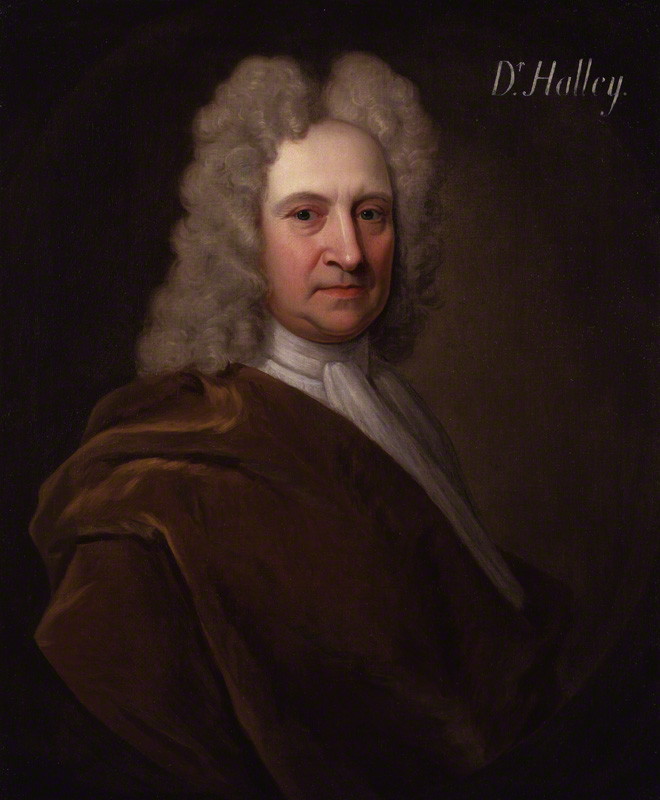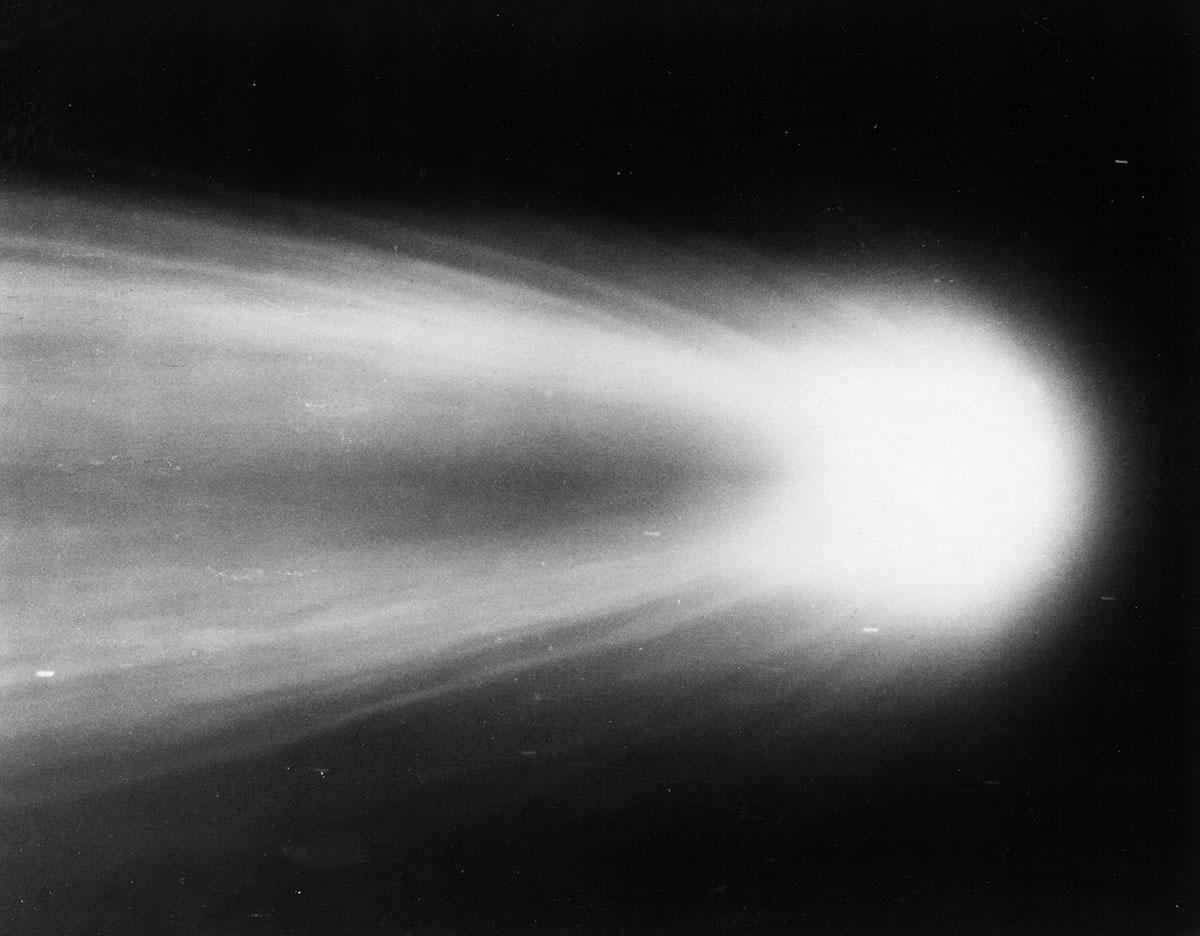Halley's Comet
Halley's Comet is perhaps the most well-known of all comets. It is a short period comet that can be seen from Earth every 76 years. It was last seen in 1986 and will next be visible from Earth in 2061. It is also known as 1P/Halley.
Halley's Comet is named in honour of English astronomer Edmond Halley (1656 - 1742). Halley wasn't the discoverer of Halley's Comet but was the first person to recognise that it was an object that orbits the Sun and returns every 76 years or so. The comet itself had been observed for thousands of years and was famously depicted in the Bayeux Tapestry as a warning to King Harold that William the Conqueror was on his way to invade England in 1066.
The main body of Halley's Comet, its nucleus, is about 15 kilometres by 8 kilometres (9.5 miles by 5 miles). At its most distant distance from the Sun, Halley's comet is about 5.2 billion kilometres away. This is about as far away as Pluto is. At its closest to the Sun, Halley's Comet comes within 88 million kilometres (55 million miles) of it. This is somewhere between the orbits of Mercury and venus.

Comets are fairly common objects in the solar system and records show that people on Earth have observed them for thousands of years. Their distinctive appearance causes them to stand out from the other objects in the sky as they look like stars with tails. They often appear out of nowhere and hang around in the sky for a few weeks, perhaps even months, before vanishing again. Most comets are rarely seen again as their orbits are so long that it takes them many thousands of years to return. These are known as long period comets. Long period comets are those with orbits of over 200 years.
Halley's Comet is a short period comet with an orbit which takes about 76 years. Despite its regular reappearances, people who had observed it in the past didn't recognise that it returns time and time again. By studying observations of an appearance in 1682, Edmond Halley noticed that it shared similarities with two other comet appearances - one in 1531 and one in 1607, and that a similar length of time had passed between each visit. This led to him suggesting that it might in fact be the same object. Its regular periodic reappearances means that it must orbit the Sun. To prove that his theory was correct, he predicted it would reappear in 1758. And lo and behold and lo again, the comet did reappear! Unfortunately, Halley died in 1742 so he didn't get to see it for himself.
In 1759, the French astronomer Nicolas-Louis de Lacaille named the comet after Halley which was rather nice of him.

Halley's Comet orbits the Sun approximately every 76 years. The gravity of the solar system's planets can disturb its journey and cause its orbit to vary, causing it to be anything between 74 years and 79 years.
When an object is at its most distant point in an orbit of the Sun, it is said to be at its aphelion. An object's closest point is called its perihelion. Halley's Comet's aphelion is about 5.2 billion kilometres which is further from the Sun than the orbit of Neptune, the solar system's most distant planet. It will next be at this point around December 2023. After then, it will head back towards the Sun and will reach perihelion on 28th July 2061. When it does, it will be about 88 million kilometres from the Sun, roughly halfway between the distance of Mercury and Venus' orbits.
Although Halley's Comet travels further out than Neptune and comes almost as close as Mercury is to the Sun, it won't collide with any of the planets. This is because it spends most of its time below them. All of the planets travel around the Sun on a level plane. Halley's Comet's orbit is titled at an angle of 18 degrees. This means its trip through the solar system doesn't take it across the path of any of the planets. It does pop its head just above the plane of the planets when it gets to perihelion, but drops back below them again soon afterwards.
Halley's Comet orbits in a retrograde direction. This means it travels in the opposite direction to the Sun's rotation. All planets in the solar system and most other comets have prograde orbits, the same direction as the Sun's rotation.
Stargazers have observed appearances of Halley's Comet for thousands of years and many ancient records still exist today. Records have been made on all kinds of materials, such as on slips of bamboo, blocks of clay, embroideries, paper and in more recent times, photographs. The earliest known record dates back to 240 BC from China. The comet's next appearance in 164 BC was recorded on clay tablets in ancient Babylon, a city situated in what is now Iraq. Each appearance afterwards has also been recorded.
Historically comets were seen as symbols of bad news, and a lot of records of Halley's Comet's appearances also link it to the deaths of rulers or military defeats. The most famous depiction of Halley's Comet is in the Bayeux Tapestry. This is a large 70 metre long embroidery that tells the story of the Norman invasion of England and defeat of King Harold II by William the Conqueror in the Battle of Hastings in 1066. About halfway through the embroidery, a comet appears, with onlookers pointing at it and news of its appearance being told to King Harold. Ghostly ships appear further along, suggesting that the comet's appearance is a sign of King Harold's forthcoming defeat and William the Conqueror's conquest of England.

Modern technology means that it is now possible to take photographs of Halley's Comet rather than just recording its appearances in drawings, paintings and embroideries. The first photographs of Halley's Comet were obtained during its 1910 appearance. Many more were taken in 1986, including some close-up shots by space craft that were sent to visit it.

When Halley's Comet last came close to Earth in 1986, it was an opportunity not to be missed to get a closer look at it. It was visited by five space craft: Giotto, Vega 1, Vega 2. Sakigake and Suisei.
Giotto was a European Space Agency mission. It launched on 2nd July 1985 and made its closest approach of Halley's Comet on 14th March 1986, getting as near as 596 kilometres to its nucleus. It sent back close-up images of the comet, revealing the shape and size of its nucleus, and measured the contents of its gas and dust tails. It discovered that most of the material ejected from it is water. Particles from Halley's Comet impacted Giotto and damaged its camera. After flying past Halley's Comet, it was deactivated on 15th March 1986. It would get switched on again in 1992 when it came close to another comet (Comet Grigg-Skjellerup) but its broken camera meant it could take no pictures.

Vega 1 and Vega 2 were two Soviet space craft that launched in December 1984 to visit the planet Venus and then Halley's Comet. They reached Venus in June 1985, dropping landers onto its surface and balloons into its atmosphere. Following this, they headed off to Halley's Comet by using Venus' gravity to redirect them. They took thousands of pictures of Halley's Comet and passed through its tail, surviving despite being battered by dust particles. Vega 1's closest approach to Halley's Comet was about 10,000 kilometres (6,200 miles) on 6th March 1986. Vega 2's closest approach was 8,030 kilometres (4,990 kilometres) on 15th June 1986. Contact with both space craft was lost in 1987.
Sakigake and Suisei were two Japanese space craft which also flew by Halley's Comet. Sakigake launched on 7th January 1985 and flew by Halley's Comet at a distance of almost 7 million kilometres. Suisei launched on 18th August 1985, flying by the comet on 8th March 1986 at a distance of 151,000 kiometres.
Further information about the Giotto mission can be found on ESA's website

Halley's Comet is also known as 1P/Halley; 1 because it was the first comet to be recognised as an object orbiting the Sun, P because it is a Periodic comet with an orbit of less than 200 years, and Halley because Edmond Halley was the first person to predict that it would return.
Halley's Comet made appearances in 1835 and 1910. American writer Mark Twain was born in 30th November 1835, two weeks after Halley's Comet's closest approach to the Sun. In 1909, he said "I came in with Halley's Comet on 1835. It is coming again next year, and I expect to go out with it. It will be the greatest disappointment of my life if I don't go out with Halley's Comet." He kind of got his wish, and died on 21st April 1910, one day after Halley's Comet made its perihelion.





